| ________________
CM . . . . Volume XVII Number 40. . . .June 17, 2011. 
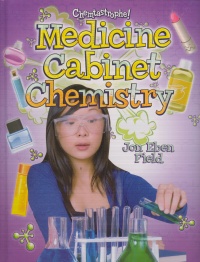 |
Medicine Cabinet Chemistry. (Chemtastrophe!).
Jon Eben Field.
St. Catharines, ON: Crabtree, 2011.
32 pp., pbk. & hc., $9.95 (pbk.), $20.76 (RLB.).
ISBN 978-0-7787-5304-9 (pbk.), ISBN 978-0-7787-5287-5 (RLB.).
Subject Headings:
Pharmaceutical chemistry-Juvenile literature.
Chemistry-Experiments-Juvenile literature.
Grades 5-8 / Ages 10-13.
Review by Barbara McMillan.
***/4
|
| |
|
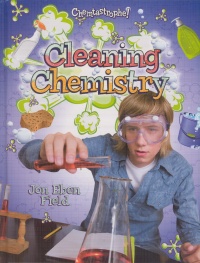 |
Cleaning Chemistry. (Chemtastrophe!).
Jon Eben Field.
St. Catharines, ON: Crabtree, 2011.
32 pp., pbk. & hc., $9.95 (pbk.), $20.76 (RLB.).
ISBN 978-0-7787-5301-8 (pbk.), ISBN 978-0-7787-5284-4 (RLB.).
Subject Headings:
Cleaning compounds-Juvenile literature.
Chemistry-Experiments-Juvenile literature.
Grades 5-8 / Ages 10-13.
Review by Barbara McMillan.
***/4
|
| |
|
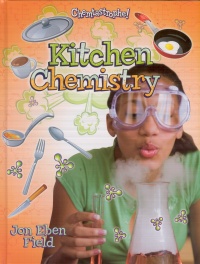 |
Kitchen Chemistry. (Chemtastrophe!).
Jon Eben Field.
St. Catharines, ON: Crabtree, 2011.
32 pp., pbk. & hc., $9.95 (pbk.), $20.76 (RLB.).
ISBN 978-0-7787-5303-2 (pbk.), ISBN 978-0-7787-5286-8 (RLB.).
Subject Headings:
Food-Composition-Juvenile literature.
Food-Analysis-Juvenile literature.
Chemistry-Experiments-Juvenile literature.
Grades 5-8 / Ages 10-13.
Review by Barbara McMillan.
***/4
|
| |
|
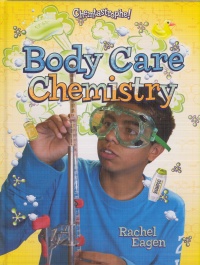 |
Body Care Chemistry. (Chemtastrophe!).
Rachel Eagen.
St. Catharines, ON: Crabtree, 2011.
32 pp., pbk. & hc., $9.95 (pbk.), $20.76 (RLB.).
ISBN 978-0-7787-5288-2 (pbk.), ISBN 978-0-7787-5282-0 (RLB.).
Subject Headings:
Cosmetics-Analysis-Juvenile literature.
Health products-Analysis-Juvenile literature.
Chemistry-Experiments-Juvenile literature.
Grades 5-8 / Ages 10-13.
Review by Barbara McMillan.
***/4
|
| |
|
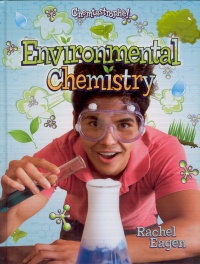 |
Environmental Chemistry. (Chemtastrophe!).
Rachel Eagen.
St. Catharines, ON: Crabtree, 2011.
32 pp., pbk. & hc., $9.95 (pbk.), $20.76 (RLB.).
ISBN 978-0-7787-5302-5 (pbk.), ISBN 978-0-7787-5285-1 (RLB.).
Subject Headings:
Environmental chemistry-Juvenile literature.
Pollution-Juvenile literature.
Chemistry-Experiments-Juvenile literature.
Grades 5-8 / Ages 10-13.
Review by Barbara McMillan.
***/4
|
| |
|
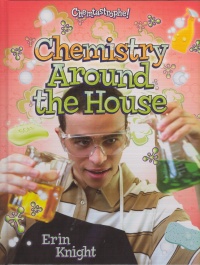 |
Chemistry Around the House. (Chemtastrophe!).
Erin Knight.
St. Catharines, ON: Crabtree, 2011.
32 pp., pbk. & hc., $9.95 (pbk.), $20.76 (RLB.).
ISBN 978-0-7787-5300-1 (pbk.), ISBN 978-0-7787-5283-7 (RLB.).
Subject Headings:
Chemistry-Juvenile literature.
Chemistry-Experiments-Juvenile literature.
Grades 5-8 / Ages 10-13.
Review by Barbara McMillan.
***/4
|
| |
|

excerpt:
Chemists can create new molecules and compounds, analyze and synthesize various substances, and predict how certain substances will interact in ways that would seem like magic to people 100 years ago. The rate of chemistry advancement is incredible. Many of the products in our medicine cabinets are inventions of the last 50 years. Just imagine what chemists will be able to do in the next 100 years. Perhaps there will be self-brushing toothpaste! (From Medicine Cabinet Chemistry.)
What most people do no know is that the skin in the armpits is naturally acidic, having a pH of 4.5 to 6. When you wash, you destroy the acidity of your skin, making it neutral or basic. This actually encourages bacteria to grow, as they thrive in highly basic or acidic environments. This is how deodorants can help. Most deodorants contain alcohol, a substance known to kill bacteria, or prevent them from multiplying in the first place. Antiperspirants work even harder to minimize body order by preventing you from sweating… they block sweat ducts in the skin. (From Body Care Chemistry.)
Wherever you are right now, try to count the number of items that are made of plastic. There are probably a lot more than you would have guessed. Would you believe that you have a Southeast Asian beetle to thank for all of the plastics you use? Like so many inventions and discoveries, plastic was also discovered through serendipity and hard work. Leo Hendrik Baekeland, a chemist, was trying to find an alternative to shellac, which was excreted by these beetles and was very expensive to collect. Baekeland made bakelite, the world’s first plastic in the early 1900s, from two other substances. Today, most plastics are petroleum products. (From Chemistry Around the House.)
When I was asked to review the six books in Crabtree’s “Chemtastrophe!” series, I wondered if the focus would be on chemical disasters. The first to come to mind was the tragedy in Bhopal, India, that is known as the world’s worst industrial catastrophe. In 1984, a Union Carbide pesticide plant exposed citizens of Bhopal to toxic gazes and toxic chemicals that resulted in 3,787 deaths immediately following the leak and 558, 125 temporary and permanently disabling injuries. Upon receipt of the series, I realized the title was merely a ploy to attract the attention of potential readers.
The “Bhopal Gas Chemtastrophy” is mentioned in Eagen’s Environmental Chemistry (p. 17). It is described in six sentences in a text box labelled “How We Know”. On the same page, under the heading, “When Chemistry Kills”, Eagen writes about Rachel Carson and her research on the biological effects of DDT that led to its banning by the U.S. government. DDT is one of several persistent organic pollutants that Eagen introduces on page 16. This general category of pollutant is also mentioned in a “How We Know” text box in Knight’s Chemistry Around the House. Like Eagen and Knight, Field uses a “How We Know” text box to describe a drug, “Elixir Sulfanilamide” in Medicine Cabinet Chemistry. This particular elixer was released in the U.S. in 1937 and killed over one hundred patients, a happening which quickly led to the Federal Food, Drug, and Cosmetic Act of 1938. Elsewhere “chemtastrophes” are relegated to notes. These are one or two sentences, in bold italics or on an illustrated page of a note pad, that warn of chemtastrophes or refer to chemtastrophes in general. For example, in Cleaning Chemistry, Field cautions that “[p]hosphate detergents are particularly harmful to the environment” (p. 17), that “mixing some substances can create a chemtastrophe” (p. 26) and that “dozens of chemtastrophes have happened because ammonium nitrate, used in some fertilizers” catches fire or explodes (p. 27). The focus of the series is definitely not chemical catastrophes. Rather, the series helps to make 10 to 13-year-old readers aware of the significant impact chemistry and the products of chemistry have had and continue to have on our chemical understanding of matter and our ability to synthesize an amazing variety of edible, medicinal, cosmetic, cleaning, industrial, and household materials. This is accomplished well. Much less prevalent are the consequences on human life and the environment when manufacturing errors occur, when the biological impacts of chemical products fail to be meticulously and systematically investigated, and when by-products of chemical manufacturing and the products, themselves, pollute the air, the water, and the land.
As is common for Crabtree series directed at this 10 to 13-year-old age range, each book is 32 pages in length with a glossary, index, and short lists of websites, books, and places like museums and science centres where more complete and up-to-date information can be obtained. Moreover, the books share a nearly identical structure and layout. Each begins with a description of science and scientific discovery that leads into a two or four-page explanation of matter and the phases in which matter can exist. Following a description of the methods of science, the authors focus on the specific context, reflected in a book’s title, through which they present “everyday” chemistry, experimental investigations in chemistry, the products of chemistry, and the work of “creative chemists.” The pages of each book in the series are illustrated with images, primarily stock photographs, and a border that resembles graph paper on which chemical symbols for compounds have been drawn. As mentioned above, these pages incorporate supplementary information as notes, “How We Know” text boxes, and a note pad with the heading “Results and Discussion”. Additional information is also found in “fun fact” text boxes at the bottoms of five or six pages in each book. One example of a “fun fact” from Field’s Kitchen Chemistry is “[l]imonene is the essential oil in a lemon’s peel that gives it a distinctly refreshing smell” (p. 12).
As misleading as the series title is, the descriptions of “the” scientific method, scientific hypotheses, scientific laws, and scientific theories are more so. This is confounded by the fact that two of the three authors of the books in the series don’t agree on the definitions and offer differing interpretations. Using scientific theories as the example, Eagen maintains that scientists construct “theories to explain their findings” and that “theories may be shortened into scientific laws, which are simple statements of scientific truths” (Environmental Chemistry, p. 11 and Body Care Chemistry, p. 11). In contrast, Field states, “A theory is a prediction about how things work. Some predictions are better than others… Many accepted scientific laws started out as theories that very few people believed… Theories become laws through testing and experimentation” (Kitchen Chemistry, p. 11). Both Eagen and Field should have been advised to follow Knight’s approach -- to focus on hypotheses as a foundation to guide scientific investigations that begin with a question -- and make no reference to laws and theories. A law in science is an empirical generalization that is expressed as a concise verbal or mathematical statement. It describes what nature does under certain conditions. A theory in science is a system of ideas or statements (not a prediction) that explains or accounts for a considerable body of evidence. It explains how nature works. As such, a theory is not a “law in waiting”.
It’s unfortunate that this series about chemistry was not created as one book with chapters on kitchen chemistry, cleaning chemistry, medicine cabinet chemistry, body care chemistry, household chemistry, and environmental chemistry written with the clarity and appeal that the excerpts above suggest. This likely would have avoided the misconceptions about the nature of science, Eagen’s confusion about the origins of chemistry, a human construct (Environmental Chemistry, p. 9), and the unnecessary redundancies that exist in the first three and the final three sections of each book. It may also have enabled the inclusion of less common investigations so that students could have been provided with more authentic experiences doing chemistry and thinking like a chemist.
Recommended with reservations.
Barbara McMillan is a teacher educator and a professor of science education in the Faculty of Education, the University of Manitoba.

To comment on this title or this review, send mail to
cm@umanitoba.ca.
Copyright © the Manitoba Library Association. Reproduction for personal use is permitted only if this copyright notice is maintained. Any other reproduction is prohibited without permission.
NEXT REVIEW |
TABLE OF CONTENTS FOR THIS ISSUE- June 17, 2011.
AUTHORS |
TITLES |
MEDIA REVIEWS |
PROFILES |
BACK ISSUES |
SEARCH |
CMARCHIVE |
HOME |





